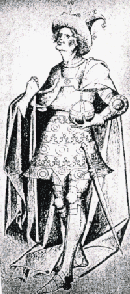Meet the Middle Ages
BackThe King

The King was the man who held the ultimate responsibility for the kingdom. In Sweden and Denmark, the King was chosen by the most prominent men in the country. In Norway, the eldest son succeeded to the throne. In reality, the difference between the three countries was not so very great. Throughout the Middle Ages, there was a struggle for the throne in the Nordic countries.
The King was also responsible for the defence of his country. He had castles built and employed soldiers. He had the supreme judicial power over his realm, he made the laws and appointed Chief Judges.
The King received an income through taxes paid by the peasants. Kking also collected money from the duty on goods and from the fines ordered by the courts. Since the King often lacked money, he often turned to the wealthy noblemen for help.
The country was divided into castle counties, "slottslän", so that it was easier to control. Bailiffs were appointed to rule the counties and see to that the taxes were paid and the laws followed.
The King had a Council to help him to rule the country. Members of the Council were the Bishops and leading noblemen. They advised the King, and made sure that his decisions were for the good of the country. The members of the Council protected their own interests as well, making sure that the decisions were to their own advantage. Throughout the Middle Ages, there was a constant power-struggle between King and Council. If the King was weak, the aristocracy could profit from it. A strong King or Queen prevented the nobility from gaining too much power.